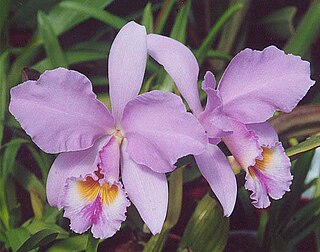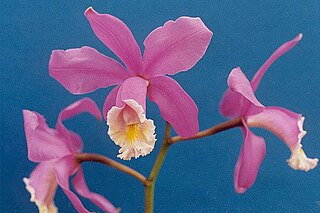
Cattleya trianae, also known as Flor de Mayo or "Christmas orchid", is a plant of the family Orchidaceae. It grows as an epiphytic orchid, with succulent leaves, endemic to Colombia where it was nominated as the national flower in November 1936. That year, the National Academy of History of Argentina asked the Latin American countries to participate in an exhibition with the representative flowers of each country. The Colombian government gave the botanist Emilio Robledo the task to designate the most representative flowering plant of the country.

Epidendrum ciliare, synonyms including Coilostylis ciliaris is a species of orchid. It is known as the fringed star orchid. It has a wide distribution from Mexico through Central America and the Caribbean to northern and western South America.

Cattleya dormaniana, or Dorman's cattleya, is a bifoliate Cattleya species of orchid. The diploid chromosome number of C. dormaniana has been determined as 2n = 40.

Cattleya forbesii, or Forbes' cattleya, is a species of orchid. The diploid chromosome number of C. forbesii has been determined as 2n = 54–60.

Cattleya gaskelliana is a labiate Cattleya species of orchid. The diploid chromosome number of C. gaskelliana has been determined as 2n = 40.

Cattleya granulosa is a bifoliate Cattleya species of orchid. It is endemic to Brazil; the type specimen was reported to come from Guatemala, but this is likely erroneous. The diploid chromosome number of C. granulosa has been determined as 2n = 40.

Cattleya guttata is a bifoliate Cattleya species of orchid. The diploid chromosome number of C. guttata has been determined as 2n = 40.

Cattleya harrisoniana is a bifoliate Cattleya species of orchid. The diploid chromosome number of C. harrisoniana has been determined as 2n = 40. The haploid chromosome number of C. harrisoniana has been determined as n = 20.

Cattleya intermedia, the intermediate cattleya, is a bifoliate Cattleya species of orchid. The diploid chromosome number of C. intermedia has been determined as 2n = 40.

Cattleya lueddemanniana is a labiate Cattleya species of orchid. The diploid chromosome number of C. lueddemanniana has been determined as 2n = 40.

Cattleya mossiae, commonly known as the Easter orchid, is a species of labiate Cattleya orchid. The white-flowered form is sometimes known as Cattleya wagneri. The diploid chromosome number of C. mossiae has been determined as 2n = 40. The haploid chromosome number has been determined as n = 20.

Cattleya nobilior is a species of orchid. The rhizanthoid Cattleyas differ from the other species of Cattleya by having inflorescences which arise directly from the rhizome, instead of from the apex of the pseudobulb. The diploid chromosome number of C. nobilior has been determined as 2n = 42, which contrasts with the value of 2n = 40 for C. walkeriana.

Cattleya percivaliana is a species of orchid. It shares the common name of "Christmas Orchid" with C. trianae and Angraecum sesquipedale. The diploid chromosome number of C. percivaliana has been determined as 2n = 40. The haploid chromosome number has been determined as n = 20.

Cattleya tigrina is a bifoliate species of Cattleya orchid. The diploid chromosome number of C. tigrina has been determined as 2n = 40.

Cattleya walkeriana, or Walker's cattleya, is a species of orchid. It differs from most species of Cattleya by having inflorescences which arise from the rhizome instead of from the apex of the pseudobulb. In its native habitat it grows as either an epiphyte or a lithophyte, sometimes in full sun, at elevations up to 2000 meters. Pseudobulbs are relatively short, bulbous or fusiform, with one or two ovate leaves at the apex. Inflorescence is one- or few-flowered, about 8" (20 cm) tall. Flowers are 4-5" (9-12 cm) across.

Cattleya warneri is a labiate Cattleya species of orchid. The diploid chromosome number of C. warneri has been determined as 2n = 40.

Cattleya warscewiczii, a labiate Cattleya, is a species of orchid.

Epidendrum calanthum is a terrestrial reed-stemmed Epidendrum orchid from the montane Tropical rainforest of Bolivia, Colombia, Ecuador, Peru, Venezuela, and the West Indies.

Cattleya elongata, the "cattleya with the elongated stalk", is an orchid species in the genus Cattleya endemic to the campo rupestre vegetation in northeastern Brazil.
Andaingo is a genus of moths in the family Limacodidae.



















